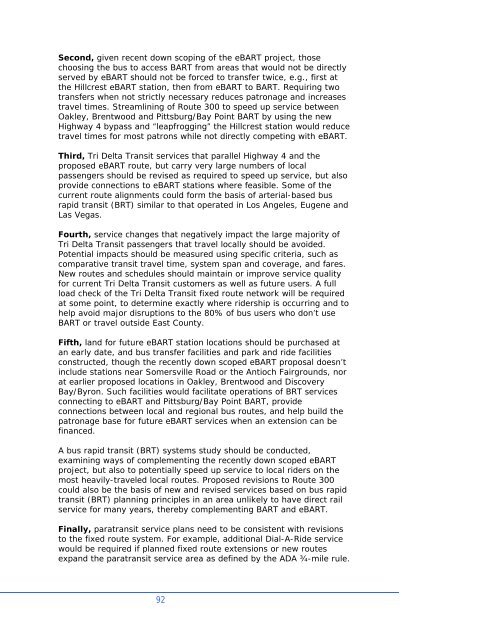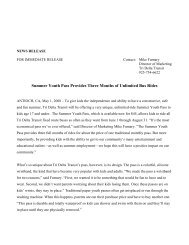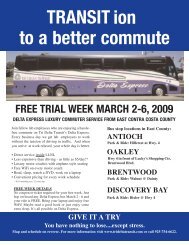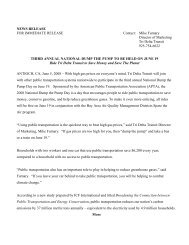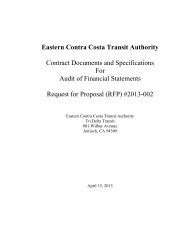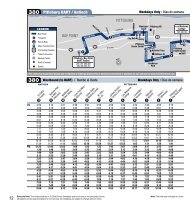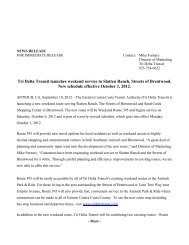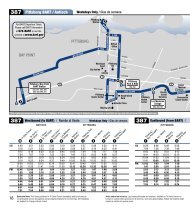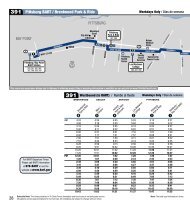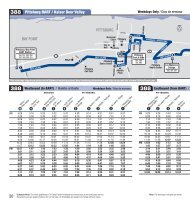to view Short Range Transit Plan FY 2007/2008 - Tri Delta Transit
to view Short Range Transit Plan FY 2007/2008 - Tri Delta Transit
to view Short Range Transit Plan FY 2007/2008 - Tri Delta Transit
You also want an ePaper? Increase the reach of your titles
YUMPU automatically turns print PDFs into web optimized ePapers that Google loves.
Second, given recent down scoping of the eBART project, thosechoosing the bus <strong>to</strong> access BART from areas that would not be directlyserved by eBART should not be forced <strong>to</strong> transfer twice, e.g., first atthe Hillcrest eBART station, then from eBART <strong>to</strong> BART. Requiring twotransfers when not strictly necessary reduces patronage and increasestravel times. Streamlining of Route 300 <strong>to</strong> speed up service betweenOakley, Brentwood and Pittsburg/Bay Point BART by using the newHighway 4 bypass and “leapfrogging” the Hillcrest station would reducetravel times for most patrons while not directly competing with eBART.Third, <strong>Tri</strong> <strong>Delta</strong> <strong>Transit</strong> services that parallel Highway 4 and theproposed eBART route, but carry very large numbers of localpassengers should be revised as required <strong>to</strong> speed up service, but alsoprovide connections <strong>to</strong> eBART stations where feasible. Some of thecurrent route alignments could form the basis of arterial-based busrapid transit ( BRT) similar <strong>to</strong> that operated in Los Angeles, Eugene andLas Vegas.Fourth, service changes that negatively impact the large majority of<strong>Tri</strong> <strong>Delta</strong> <strong>Transit</strong> passengers that travel locally should be avoided.Potential impacts should be measured using specific criteria, such ascomparative transit travel time, system span and coverage, and fares.New routes and schedules should maintain or improve service qualityfor current <strong>Tri</strong> <strong>Delta</strong> <strong>Transit</strong> cus<strong>to</strong>mers as well as future users. A fullload check of the <strong>Tri</strong> <strong>Delta</strong> <strong>Transit</strong> fixed route network will be requiredat some point, <strong>to</strong> determine exactly where ridership is occurring and <strong>to</strong>help avoid major disruptions <strong>to</strong> the 80% of bus users who don’t useBART or travel outside East County.Fifth, land for future eBART station locations should be purchased atan early date, and bus transfer facilities and park and ride facilitiesconstructed, though the recently down scoped eBART proposal doesn’tinclude stations near Somersville Road or the Antioch Fairgrounds, norat earlier proposed locations in Oakley, Brentwood and DiscoveryBay/Byron. Such facilities would facilitate operations of BRT servicesconnecting <strong>to</strong> eBART and Pittsburg/Bay Point BART, provideconnections between local and regional bus routes, and help build thepatronage base for future eBART services when an extension can befinanced.A bus rapid transit (BRT) systems study should be conducted,examining ways of complementing the recently down scoped eBARTproject, but also <strong>to</strong> potentially speed up service <strong>to</strong> local riders on themost heavily-traveled local routes. Proposed revisions <strong>to</strong> Route 300could also be the basis of new and revised services based on bus rapidtransit (BRT) planning principles in an area unlikely <strong>to</strong> have direct railservice for many years, thereby complementing BART and eBART.Finally, paratransit service plans need <strong>to</strong> be consistent with revisions<strong>to</strong> the fixed route system. For example, additional Dial-A-Ride servicewould be required if planned fixed route extensions or new routesexpand the paratransit service area as defined by the ADA ¾-mile rule.92


